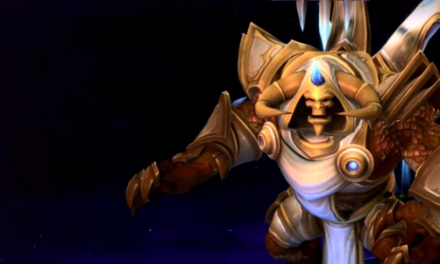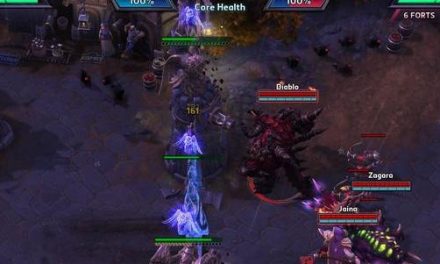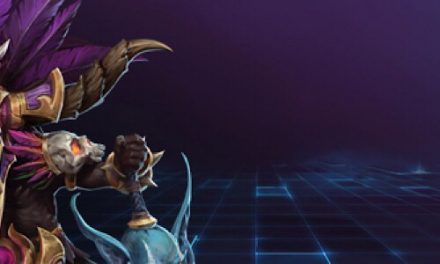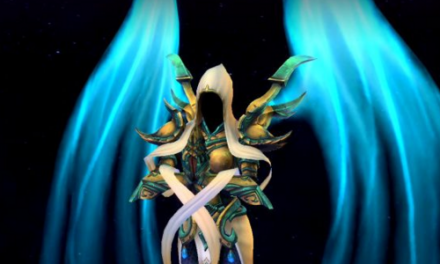Brawl-mode games in Heroes of the Storm are usually short affairs, lasting twenty minutes or so. With only a single lane of action and no ability to heal by returning “home,” teams of heroes are pitted against one another until one side finally strikes down the other’s core. Team compositions—meaning which heroes are available to play—are quite varied and random, and so often less-than-ideal matchups happen, such as one team having an extra healer, or no frontline tank, or too few DPS characters.
Being unbalanced provides severe drawbacks, but also specific opportunities. I have seen teams of almost any composition stopping “ideal” opponents, and I admit I never get tired of doing so. Without going heavy into specific mechanics or the particulars of any one hero, I want to present the following scenario:
The Balanced Team (Blue)
- One tank, able to initiate fights and protect squishier teammates
- One support healer, working to keep their allies alive and active
- One bruiser, a hero who inflicts sustained damage
- Two assassins, heroes who excel at burst damage
The Unbalanced Team (Red)
- One tank
- Two healers—perhaps one single-target and the other area-based
- Two damage dealers, both brawlers
On paper, though the red team has more healing, blue has a much higher damage potential—particularly when it comes to “spiking” a target from 100% to dead. Assuming both teams are played with the same skill level, invariably the balanced team will dominate the early game, racking up kill after kill as they inexorably push red back behind structures, perhaps even all the way to their keep.
Around level 13 however, something changes. The red team starts weathering assaults more easily, and even sends blue reeling once or twice, perhaps for the first time all match. With a big push, they’re able to knock down the front line of walls and towers.
By level 16, the game seems to be firmly in red’s favor and they seem to control the battlefield, steamrolling blue’s attempt at stopping them. With an unfortunate death on blue’s part leading to total collapse, red is able to destroy the core and win the game.
What happened?
As a team levels up, not only do they unlock more abilities and traits to modify them, their base skills become more powerful as well. A level 1 Raynor deals 101 damage per basic attack. A level 20 Raynor deals 221. Different character classes (Bruiser, Healer, Assassin, Support, Tank) scale differently with level, and they shine at different parts of the match.
Assassins and Bruisers are exceptionally effective at early to mid levels, where they can kill poorly-located enemies, even those under the active attention of a healer. The longer a match continues, however, the more the battlefield favors supporting roles like Healing, Support, and Tank. Somewhere around the mid-game, all of a sudden a defensive-minded team will start pulling ahead, so long as they can hang on to that point.
As above, a level 1 Raynor does 101 damage with his Basic Attack. A level 1 Diablo has 2670 health; the tank will die after 27 attacks by the assassin. At level 20, Raynor does an impressive 221 damage but Diablo can have a full 8190 health—meaning he can soak 37 shots and still have health to spare. Time favors the tanks.
In Brawl games that are well-matched, meaning both teams have a fair shot at winning, I routinely see it take until level 20 for the first fort to fall, meaning 100% of the combat has been in the central no-mans land. These games either finish rather quickly at that point, one team capitalizing on the failings or insufficient scaling of the other, or they grind up to level 30 as evenly-matched and similarly-composed teams see-saw their way across the battlefield.
Alternatively, I have seen Brawl games end at level 11. While far more rare, a team expressly designed to deal damage can overwhelm opposing healers, eventually taking down structures quickly. Unless the defenders can mount a sizable reversal of fortune, the game will quickly end.
Often players will talk about their teams as an “early-game comp” or “late-game comp,” referring to the time frame in which they can be most successful. Teams focused on the early game need to make their brief window of opportunity count, hopefully crippling the opponents’ ability to strike back by the time their power blossoms. Late-game teams, by contrast, need to hold on and play stalwart defense until they start outscaling their foes, if they want a chance at success.
Late-Game Heroes include Nazeebo, Zul’jin, Tassadar, Butcher, and Cho’Gall, and they start excelling around level 16 or higher.
Early-Game Heroes include Kerrigan, Tracer, Zarya, and Chromie, and they start getting outshined after level 13.
When I’m playing Nazeebo and someone decries my anemic damage at level 7, I don’t pay them any mind, because I’m reasonably sure that I’ll be crushing them by the end of the game. If conversely a Zul’jin is making fun of my Tracer at level 18, I try not to mention the first 15 minutes of the game where Zul’jin had the lowest damage on the team and I was dominating the charts.
It’s important to consider not only the type of match (brawl, league, other) but also the total team composition when it comes to planning for success. Without enough push early game, the other team may achieve an insurmountable advantage that will be too difficult to overcome. Without enough late game power, there may be no hope of winning if the game stretches on.
Which is best? As with so many aspect of Heroes of the Storm, more than anything success comes down to map awareness, teamwork, and knowing the specific strengths (and weaknesses) of your own character. A team filled with great early-game heroes can still destroy a team filled with late-game heroes at the 25th minute, if the latter aren’t organized or playing to their own advantages.
Header image taken from gameplay for Remnant: From the Ashes, which I think has a very neat aesthetic for video games, something of a Call of Cthulhu premodern noir grittiness and methodology.













